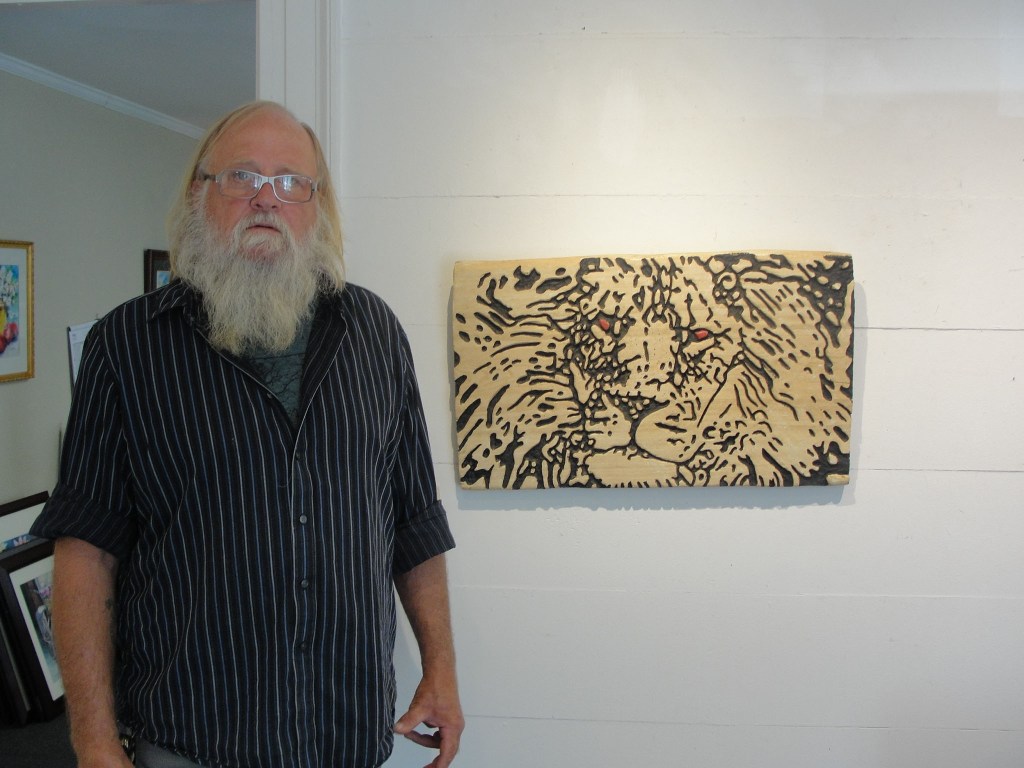Wood sculptor’s work to be displayed at Milledgeville Allied Arts
Published 2:00 pm Friday, May 27, 2016

- David Williams said this lion is one of his favorite pieces, yet it was created by accident. He had initially started carving something else, but due to errors, he was unable to continue and instead turned the carving into a lion.
MILLEDGEVILLE, Ga. — While painting, drawing and graphic design are all art forms many people can do, though few master, David Williams has an art form that few have ever tried.
“I’ve been carving since I was probably 9 years old,” Williams said. “I would sit around with my dad and grandfather. They all used to whittle. I got a pocketknife at a young age and I’d sit there and whittle.”
Trending
Williams said he still has the pocketknife, though he’s since lost many of the pieces his father has carved and given to him over the years.
While whittling is the first time Williams was ever exposed to carving, he has since graduated from pocketknives and a small piece of wood to large logs and chainsaws.
“I’m 62 now, and I started doing this when I was 9. I’m not good with math, but I’ve been doing it a long time,” Williams said. “I used to do it with a mallet and chisel, but now I do it with a chainsaw. I have very little patience. I’ve just got all these ideas and images in my head, so I want to get it done and move on to the next thing.”
Williams said that while he was never very good with academic education, he has always been good with his hands.
“I’ve always been good with my hands. If I can see it, I can make it, and imagination is a terrible thing to waste,” Williams said.
Williams graduated from the University of North Carolina Wilmington. While there, he studied sculpture and painting with the intent of becoming a teacher; however, he said that by the time he graduated, shop class was no longer being taught in most schools.
Trending
Williams never cuts down any live trees to make his art. Instead, he walks through the woods near his home in Sparta looking for tress that have been downed naturally from wind, lightning or animals. He also takes wood from people who offer it to him after they cut down a tree.
“I don’t cut down any live trees. I like trees. They’re a living thing,” Williams said. “A lot of people, me too, went hunting and just killed things, but there’s no need to. I like to surround myself with everything that makes me feel good, and I don’t feel good about cutting down a tree for no reason when there’s plenty of wood around.”
Williams said that foresters have to pay to dump wood they’ve cut, so he’ll often take from them. With more wood already cut than he can use in a lifetime, Williams said that it’s free material that would otherwise rot. Even damaged wood, he said, has a lot of color inside.
Because trees are living things they are susceptible to disease, water damage, rot, fungus and insects. All of those things can change the physical characteristics of the wood from the tree, most notably the color. Knots in wood are formed from branches in the tree, insects and birds will often chew into a tree, sometimes with distinct black marking left behind. Water damage influences mold growth and bacteria inside trees, then giving different species different colors. While most builders will avoid trees damaged by insects, fungus, rot and birds due to the possibility of structural weakness, carvers highly prize these pieces due to the different color striations.
Wood also has a tendency to crack when it dries, especially if the heartwood is left in a piece. Different waxes can be put on wood to make the wood dry more slowly, and thus crack less, but when finding wood in the forest that has been downed naturally, many pieces have already mostly dried and cracked.
Williams said that instead of working around cracks and color variations, he will incorporate those into the pieces he carves.
“Even damaged wood, with water damage, has a lot of color inside it and looks very beautiful when you put a finish on it,” Williams said.
Williams saves all the pieces that come from his carving. He even keeps empty coffee cans full of sawdust, each labeled with the type of wood it came from. When he encounters a problem in the wood or makes a small mistake in carving, he will mix the dust up with wood glue to make a wood filler, thus hiding or completely repairing the damage. He said mixing sawdust with polyurethane or other finishes will dry and harden to the consistency of a nail.
Many carvers and wood turners avoid pine, and Williams agrees. The wood is typically soft and easily damaged, and the sap can be challenging to deal with. Sweetgum, a wood common in this area and closely related to pine, is another wood that most people avoid; however, Williams likes it.
“I just did two bowls out of sweetgum,” Williams said. “Everybody tells me it’s nasty wood, but the grain looks like smoke. It just rolls and rolls.”
He also likes popular, oak, hickory and sycamore, but his favorite wood is black walnut.
“It smells like chocolate when you’re working with it,” Williams said. “It’s a hard wood to come by and a really beautiful wood. Sometimes it has a light color grain. It’s a great wood to work with. I’ve got a couple roosters (made from it) that are really nice.”
Williams said that while most people say they can’t carve, he said that in a day’s time others can do work just as good as his.
“In Florida, I went down there and would teach wood carving to kids. Now I do it here. I have a couple kids from Washington County come over,” Williams said. “Everyone says they can’t do it, but by the end of the day, they’re doing work just as good as I can do. Some said it doesn’t look like mine, but I like what they did. It’s different, but it was nice. Nobody really wants to take the time, but with an openness to listen, you can really do something. Even [Ga.] Gov. [Roy] Barnes put me on GPTV three times with wood carving.”
Williams’ sculptures will be on display at Allied Arts from June 5 through Aug. 5. A reception will be held from 1 to 3 p.m. June 5. The John Marlor Arts Center, 201 N. Wayne St., is open from 9 a.m. to 4 p.m. Monday through Friday or by appointment. Admission is free, and Williams’ work can be purchased. For more information, call Allied Arts at 478-452-3950 or visit milledgevillealliedarts.com.





